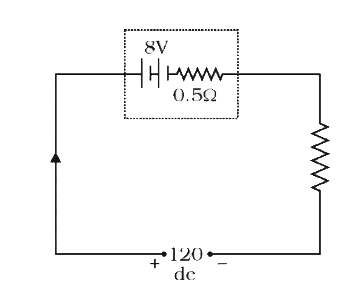A storage battery of emf 8.0 V and internal resistance 0.5Ω is being charged by a 120V dc supply using a series resistor of 15.5Ω what in the terminal voltage of the battery during charging ? What is the purpose of having a series resistor in the charging circuit?
To find the terminal voltage of the battery during charging, we can follow these steps:
1. Identify Given Values:
- EMF of the battery (E) = 8.0 V
- Internal resistance of the battery (r) = 0.5 Ω
- External resistor (R) = 15.5 Ω
- Supply voltage (V_s) = 120 V
2. Determine Total Resistance in the Circuit:
The total resistance (R_total) in the circuit is the sum of the internal resistance of the battery and the external resistor:
Rtotal=R+r=15.5Ω+0.5Ω=16.0Ω
3. Calculate the Current (I) in the Circuit:
Using Kirchhoff's loop law, we can set up the equation for the circuit:
Vs−I⋅R−E−I⋅r=0
Rearranging gives:
I⋅(R+r)=Vs−E
Substituting the values:
I⋅16.0=120−8
I⋅16.0=112
I=11216=7A
4. Calculate the Terminal Voltage (V_t) of the Battery:
The terminal voltage (V_t) can be calculated using the formula:
Vt=E+I⋅r
Substituting the known values:
Vt=8+7⋅0.5
Vt=8+3.5=11.5V
5. Conclusion:
The terminal voltage of the battery during charging is 11.5 V.
6. Purpose of the Series Resistor:
The series resistor is used to limit the current flowing into the battery during charging. Without this resistor, the current could be excessively high, potentially damaging the battery.
- EMF of the battery (E) = 8.0 V
- Internal resistance of the battery (r) = 0.5 Ω
- External resistor (R) = 15.5 Ω
- Supply voltage (V_s) = 120 V
The total resistance (R_total) in the circuit is the sum of the internal resistance of the battery and the external resistor:
Rtotal=R+r=15.5Ω+0.5Ω=16.0Ω
Using Kirchhoff's loop law, we can set up the equation for the circuit:
Vs−I⋅R−E−I⋅r=0
Rearranging gives:
I⋅(R+r)=Vs−E
Substituting the values:
I⋅16.0=120−8
I⋅16.0=112
I=11216=7A
The terminal voltage (V_t) can be calculated using the formula:
Vt=E+I⋅r
Substituting the known values:
Vt=8+7⋅0.5
Vt=8+3.5=11.5V
The terminal voltage of the battery during charging is 11.5 V.
The series resistor is used to limit the current flowing into the battery during charging. Without this resistor, the current could be excessively high, potentially damaging the battery.
Topper's Solved these Questions
- BOOK - CENGAGE PHYSICSCHAPTER - ELECTRIC CURRENT AND CIRCUITEXERCISE - Single Correct72videos
ELECTRIC CURRENT AND CIRCUIT
- BOOK - CENGAGE PHYSICSCHAPTER - ELECTRIC CURRENT AND CIRCUITEXERCISE - Multiple Correct16videos
ELECTRIC CURRENT AND CIRCUIT
- BOOK - CENGAGE PHYSICSCHAPTER - ELECTRIC CURRENT AND CIRCUITEXERCISE - Exercise 5.250videos
ELECTRIC CURRENT AND CIRCUIT
- BOOK - CENGAGE PHYSICSCHAPTER - ELECTRIC CURRENT & CIRCUITSEXERCISE - Kirchhoff s law and simple circuits15videos
ELECTRIC CURRENT & CIRCUITS
- BOOK - CENGAGE PHYSICSCHAPTER - ELECTRIC FLUX AND GAUSS LAWEXERCISE - MCQ s38videos
ELECTRIC FLUX AND GAUSS LAW
Similar Questions
A storage battery of emf 8.0 V and internal resistance 0.5 Ω is being charged by a 120 Ω d.c. supply using a series resistor of 15.5 Ω . What is the terminal voltage of the battery during charging ? What is the purpose of having a series resistor in the charging circuit ?
View SolutionA storage battery of emf 8V and internal resistance is being charged by a 120 V D.C. supply using a series resistor of What is the terminal voltage of the battery during charging? What is the purpose of having a series resistor in the charging circuit?
 View Solution
View Solution
Knowledge Check
- Question 1 - Select One
A battery of emf 8 V with internal resistance 0.5Ω is being charged by a 120 V dc supply using a series resistance of 15.5Ω. The terminal voltage of the battery is
A20.5 VB15.5 VC11.5 VD2.5 V - Question 2 - Select One
A battery of EMF 10 V, with internal resistance 1Ω is being charged by a 120 V d.c. supply using a series resistance of 10Ω. The terminal voltage of the battery is
A20 VB10 VCZeroD30 V
A storage battery of emf 8V and internal resistance is being charged by a 120 V D.C. supply using a series resistor of What is the terminal voltage of the battery during charging? What is the purpose of having a series resistor in the charging circuit?
 View Solution
View SolutionA storage battery is of emf 8V and internal resistance 0.5 ohm is being charged by d.c supply of 120 V using a resistor of 15.5 ohm
a) Draw the circuit diagram.
b) Calculate the potential difference across the battery.
c) What is the purpose of having series resistance in this circuit?View SolutionA cell of emf 4V and internal resistance 1Ω is being charged by DC source of 10V through resistor of 5Ω .Calculate the terminal voltage across the cell -
View Solution(i) A storage battery of emf 8V, internal resistance 1Ω is being charged by a 120V d.c. source using a 15Ω resistor in series in the circuit. Calculate the current in the circuit (ii) terminal voltage across the battery during charging and (ii) chemical energy stored in the battery in 5 minutes.
View SolutionA battery of emf 2.0V and internal resistance 0.10Ω is being charged with a current of 5.0A. Find the potential difference between the terminals of the battery?
View SolutionA car battery of emf 12 V and internal resistance 0.1 Ω is being charged at a constant current of 5 A. The potential difference between the two terminals of the battery is ______.
View Solution

